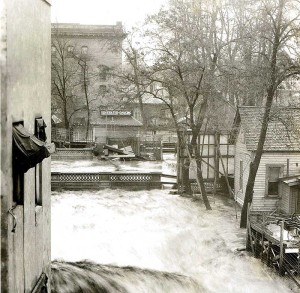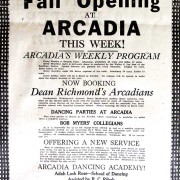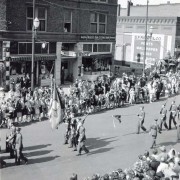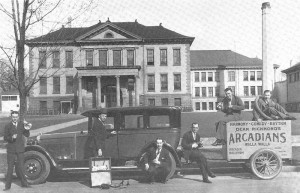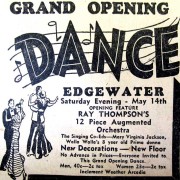Welcome to the Edgewater Dancing & Arcadia Ballroom History Website
The Edgewater Park Dance Pavilion
The Edgewater Park dance pavilion was located just east of Colville Street between Main & Alder on the south bank of Mill Creek from about 1926 to about 1945. It was considered one of the finest outdoor dance facilities in the country, featuring both local and touring bands.
Edgewater offered open dancing, dance contests, dance exhibitions, jitney dancing, as well as boxing and wrestling matches and other events. Jitney dancing was the practice of paying for each dance in advance. Admission to a Jitney dance was free, but once inside the pavilion, dancers were escorted to a roped off area where they purchased tickets for a few cents per dance. There were usually 16 dances per hour, and between numbers, rope boys cleared the dance floor and collected the money for the next number.
One of the first orchestras to play at Edgewater was led by Jackie Coogan, an early child star of the movies, with Betty Grable, later a prominent actress, as soloist. The Edgewater itself was featured in a film called “Movie Balls” whose chief photographer said it was “one of the most attractive outdoor settings for filming dance scenes I have ever seen. There may be larger and more expensively equipped pavilions along the coast, but none have a better natural setting than this.”
Edgewater Park was on land owned by the Schwarz family. It was developed with the idea that an outdoor dance pavilion would be a worthwhile addition to the city’s recreation resources. During the winter and when there was inclement weather, the dancing was moved to the Arcadia Ballroom
The Arcadia was a dependable and attractive place to go when it was rainy or cold. But when the weather was good, the Edgewater with its 8,000 square foot dance pavilion and cool breezes off the water was the place to be for dancers throughout southeast Washington and northeast Oregon. Willows lined the creek, there were benches along the railing, a bandstand on the east end, and strings of lights lit up the night.
The Arcadia Ballroom
The Arcadia Ballroom was located on the upper floor of the old Armory Building where the Land Title Plaza is now located at First and Main on the west side of Mill Creek.
The Arcadia featured public dances several nights a week and on all holidays, boxing and wrestling events, roller skating, and private parties, along with the Arcadia Dancing Academy.
During Prohibition, it wasn’t unusual to see 500 couples on a Saturday evening on Arcadia’s hardwood dance floor built over a sand base.
The premier Walla Walla band was the Arcadians, billed as “Southeastern Washington’s Greatest Dance Band.”
The Arcadians
The Arcadians were billed as “a modern dance orchestra that combines all the natural spirit of youth with the musical skill of years of experience into a group playing all the latest types of dance music with an unusually fine rhythm colored with beautiful harmonic effects.”
Instruments represented in the band over the years included violin, saxophone, clarinet, trumpet, drums, and piano, along with vocalists. In addition to playing regularly at the Arcadia Ballroom and Edgewater Park, the group toured the Northwest.
Other Bands
A variety of other local and touring bands also played the at Edgewater and the Arcadia, including, among others, the Whitmaniacs, the Multnomah Hotel Orchestra, Sig Thorsen, Harry Snider, the Croxdale Serenaders, Les Hite & his Harlem Cotton Club, Kay Barclay & her All Girl Orchestra, Ernie Fields, and Ray Thompson.
Walla Walla 2020 Historic Research & Plaque Project
Information on the Walla Walla 2020 Historic Research & Plaque Project is available here or by calling 509-522-0399.
Edgewater Park Dance Pavilion History Panel
Additional Resources
Edgewater Park Dance Pavilion & The Arcadia Ballroom Brochure
Photos & Ads courtesy of
Bygone Walla Walla:
Arcadia Ballroom
Edgewater Dance Pavilion
Photo Credits
Arcadians photo from Walla Walla, A Nice Place to Raise a Family by Bob Bennett. All others from Bygone Walla Walla by Joe Drazan.

